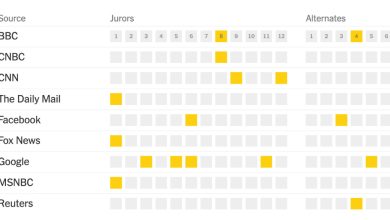The Simple, Innocent Joy in GIFs

How can one explain to a member of Gen Z the wide-eyed wonder so many of us experienced at first sight of the Dancing Baby wiggling its way across 1990s computer screens?
Not easily, is the answer. Just ask my 16-year-old, who I subjected to a demonstration of the famous GIF after learning of the untimely death of Stephen Wilhite, credited with creating the graphical format, after succumbing to complications from Covid at just 74. Wilhite has said it was a favorite of his.
According to my son, Dancing Baby is “basic” and is akin to looking at hieroglyphics. Perhaps I should have expected as much since he’s grown up with the internet. For him, the ghostly infant born before he was and whirling to a Ooga Chaka beat was not all that, even though it was everything for his mom.
GIFs call to mind what seems a simpler time online, before the immediacy and noise and flashing and rancor of the internet took hold. These days, spend too long online and it starts to feel like 3 a.m. on the Las Vegas Strip, deadening and deafening with menacing spirits lurking on the edges, barely perceptible.
Back when Wilhite and his fellow computer engineers labored at the early internet service CompuServe in the 1980s, they were guided by a simpler goal of making digital a delight for the masses and not just a geeky sideshow. The GIF embodied that by delivering a simple emotion to make us laugh or scoff or snort. Universal emotions connecting people across long distances in one of the purest of ways.
Am I making too much of it? Not a bit. Like when the first refrains of a favorite song from high school come on the radio, seeing that gyrating baby whooshes me right back to when I really liked technology in the most hopeful of ways. Actually, to when I loved it.
GIFs were a necessary creation at a time when internet speeds were outpaced by molasses and there was a need to figure out a way to efficiently move better-quality graphics in color. The first GIF Wilhite created was of an airplane and it, well, took off from there.
While we’re at it, you’re probably pronouncing it wrong. It’s “jif,” just like the peanut butter, with a soft “G” and not “gif” with a hard one like in “gift.” But don’t take my word for it: Wilhite himself explained this to an audience at the Webby Awards and to The Times. “The Oxford English Dictionary accepts both pronunciations” he said. “They are wrong.” (Please do not miss his perfect Webby acceptance speech, which only allows five words, via GIF.)
Maybe a GIF is just a little thing, but the little things matter. And what’s wrong with some brief momentary distraction as we stand on the precipice of whatever Web3 will turn out to be?
Wilhite, the technologist, also led what appears to be a very fine analog life. According to his obituary page, “even with all his accomplishments, he remained a very humble, kind and good man.”
Basic, I guess. And cool — so, so cool.
4 Questions
Lee Eisenberg and Drew Crevello, the showrunners for “WeCrashed,” now on Apple TV+, passed along their thoughts on the hit series detailing the rise and near complete collapse of WeWork. I’ve edited their answers.
Of all the series the tech gods brought to Earth for our streaming pleasure, your depiction of the WeWork debacle as a love story was quite novel and, really, exactly right. I loved the show. Tell me why you took this approach?
Crevello: Adam Neumann always says — in interviews, in his commencement address at his alma mater — that there would be no WeWork without his wife Rebekah, and he would be nowhere without her. The more we researched, and talked to former employees, and childhood friends, and associates, the more we realized: He was right. This wasn’t exaggeration, or just something sweet to say about his wife. Rebekah gave him the words — the high-minded philosophy — to package his sales pitch. This was a guy hustling the kinds of harebrained products you’d see on late-night infomercials before he met her (Onesies with kneepads for babies. Collapsible women’s heels.) Without her, we think he’d still be doing that. So it wasn’t a creative decision as much as a reflection of reality.
In particular, the portrayal of Rebekah and Adam Neumann by Anne Hathaway and Jared Leto managed to be both devastating and also sympathetic, although I doubt either real person would think so. What were you trying to do by making them such ridiculous and even abusive characters but also persuading the audience to root for their crazy ventures?
Eisenberg: Dramatically, you want the audience invested in your main characters. They don’t have to love them. Or even like them. But they have to be interested in them. We simply tried to make them as interesting as possible — because the real people are so fascinating and flawed and strange and human and relatable and alien all at once.
Critics have said you were not hard enough on them about their abuse of WeWork employees — offering low wages in exchange for a sham shot at the dream — and then running away with all the gains. I thought the employees were always willfully ignorant, but it’s clear it was a cultlike attraction. Do you see it as that? Or was it just a long con?
Crevello: We wanted the audience to be seduced by Adam Neumann the way that his employees and investors were. Adam is part rock star, part cult leader, and part genius salesman. The question we wanted the audience to debate after watching was exactly your question: was Adam a cynical opportunist or an idealistic visionary gone wrong?
Have you heard from the Neumanns or any other top character like Masa Son? Were you ever worried about their reaction? And what do you think of Adam’s latest idea about disrupting rental housing?
Eisenberg: We have not spoken to the Neumanns or to Masa. Some people have told us we went too far in our portrayal, while others say not far enough. So you’re never going to please everyone. But we want everyone — including the Neumanns and Masa — to watch. As for Adam’s new business, we’d take that bet. We think Adam learned some tough lessons from his WeWork experience, so the combination of his salesmanship and nose for deals, peppered with some added life experience, well that sounds like a Season 2 …
Lovely & Loathsome
Lovely: I am reminded this week of one of the first popular and broadly accessible plug-and-play computers, the Tandy TRS-80. The under-$600 device sold starting in the late 1970s in Tandy’s RadioShack stores, hence the abbreviation TRS. Glitchy and unreliable, the TRS-80 was derisively known as the “Trash-80.” But it was the first one I — and many others — ever used, in part because it was portable. That allowed me to haul it around to things I needed to cover in real time as a fledgling Washington Post reporter. Even a young Bill Gates made exclusive software for the computer, before turning his attention to another software project you may have heard of.
I’ve been thinking about the TRS-80 because the man who led the team that introduced it, John Roach, died this week. Roach’s team’s creation was a big seller in the 1980s, before being overtaken by more innovative computers in the following decade. But it still holds special sentimental value for me. I’ve thrown away innumerable devices over the years, but not my TRS-80, along with its protective pleather case and a pair of telephone couplers, which I used to attach to pay phones for transmitting my articles remotely. In a related note, consider the futility of explaining the concept of pay phones to your kids — trust me I’ve tried!
Loathsome: Once again, and obvi, Russia. This week the rogue nation’s internet and communications regulator, called Roskomnadzor, has blocked Google News locally. The search giant said, diplomatically, that it wasn’t its fault that many Russians were unable to access Google News since there were no technical issues. Roskomnadzor told the Interfax News Agency that Google had “provided access to numerous publications and materials containing unreliable, publicly significant information about the course of the special military operation in Ukraine.” I don’t have the energy to unpack that load of codswallop, so let’s just try to come up with a name for a digital version of the Iron Curtain. I’ll start: The Digital Drapery.



